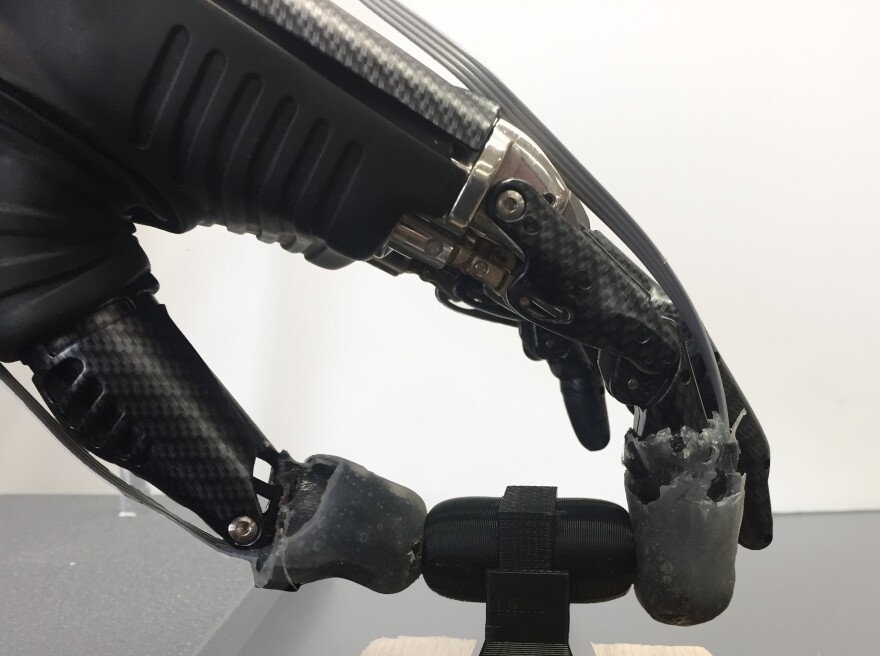Researchers have developed a new part for a prosthetic hand: a synthetic skin that can feel pain. The electronic dermis, or “e-dermis,” fits over the fingertips of a prosthetic hand and helps amputees differentiate between something sharp and something round.
Host Frank Stasio talks to Luke Osborn, a biomedical engineering graduate student at Johns Hopkins University, about how this technology works. He spends the rest of the hour with researchers and experts who have examined the nature of pain, how it can be informative, and how it is treated.
So, why is pain detection a good thing? Pain is uncomfortable, but it is also a necessary feeling that helps the body determine danger. There is also an emotional and psychological component of pain that is often overlooked. Stasio also talks to Seema Patidar, a pain psychologist at the UNC Pain Management Center. She is an assistant professor of anesthesiology at the University of North Carolina at Chapel Hill. William Maixner also joins the conversation to talk about the effect of chronic pain on the brain and the need for more chronic pain research. He is the president of the American Pain Society and a professor of anesthesiology at Duke University School of Medicine, where he co-directs the Center for Translational Pain Medicine.

Despite continued efforts to understand the complexity of pain, the medical profession tends to be more dismissive of women’s pain than men’s. This phenomenon is documented in a new book by writer and editor Maya Dusenbery. She examines how when expressing pain, women face a Catch-22: displaying too much pain could lead doctors to label them as overreacting, but displaying too little pain may make a doctor question that there is any pain at all. Women often struggle at the doctor’s office with medical professionals who do not believe that there is pain or attribute the pain to a psychogenic cause. Dusenbery talks with host Frank Stasio about her research from “Doing Harm: The Truth About How Bad Medicine And Lazy Science Leave Women Dismissed, Misdiagnosed, And Sick.” (HarperCollins Publishers/2018)
Interview Highlights
We use pain as a protective mechanism and a lot of times we take it for granted because it's something that we don't always want to experience or feel. - Luke Osborn
Osborn on why pain is an important sensation to recreate in a prosthesis:
What we're trying to do with this research is create more lifelike prosthetic limbs and that includes sensations of both pressure and pain. And if you think about it, a prosthesis isn't able to heal itself the same way somebody with an intact hand may be able to. So if you damage your skin, say with a cut, eventually your skin will heal itself. With the prosthesis, it doesn't have that self-healing ability just quite yet. So by providing the user some indication that what they're handling is potentially damaging to the prosthesis, it in a way helps make their device a little more lifelike.
Medical students on average receive about seven to nine didactic hours on pain and pain management in their academic career. Dental students, it's about 15 hours, and veterinarians, it's about 30-35 hours. - William Maixner
Patidar on the function of pain:
Typically pain is a signal that tells us we're in danger. It keeps us safe. It's an adaptive mechanism, and the problem is we usually pay attention to pain when it becomes maladaptive, when it really becomes dysfunctional. So think of a house alarm: it’s supposed to keep you safe. If there's an intruder it should go off. So that's ultimately how our nervous system is responding to pain. However, if that system just keeps going off, then you don't know if you're in danger, and it becomes really annoying.
Maixner on the effectiveness of behavioral interventions for chronic pain:
There's more and more recognition that there is not this separation of mind and body, that the psychological variables have a true neurochemistry, a true neurobiology behind them. And that the interventions that are applied from a behavioral perspective are very effective in changing the brain's neurochemistry. And so it's a modality, a set of modalities, that we should introduce early on. And in fact most studies show that long-term management of chronic pain is better done with behavioral interventions and psychological interventions, which change the chemistry and the architecture of the brain — the way in which the brain codes information.
Pain tells you to stop. And then the physical therapist and I are telling you to go anyway. That's hard. - Seema Patidar
Dusenbery on doctors ignoring women’s pain:
At this point the problem is very systemic. It's about what doctors, regardless of their own gender, are learning in medical school, and it's really unconscious. It's about these unconscious biases that all of us hold from living in a culture that has stereotypes about women and men.









